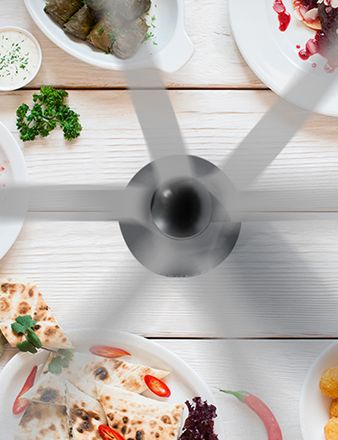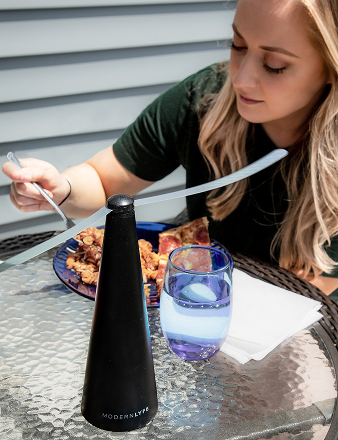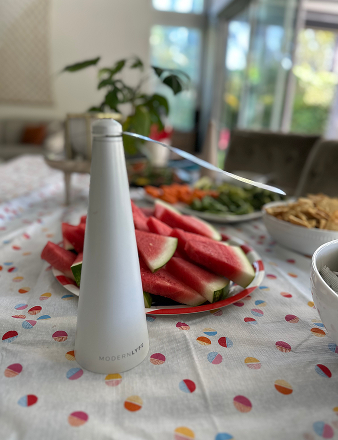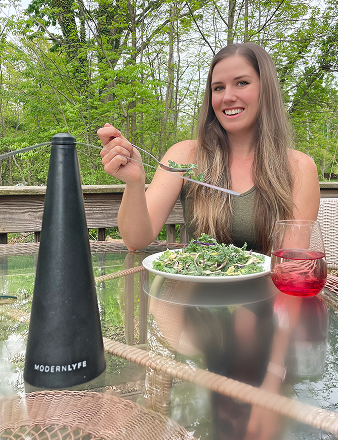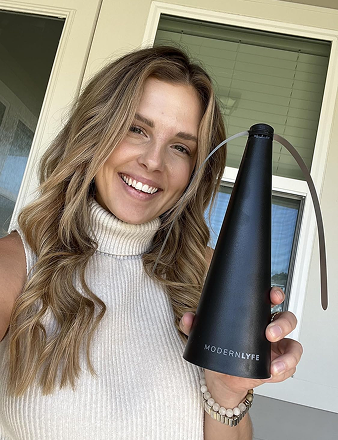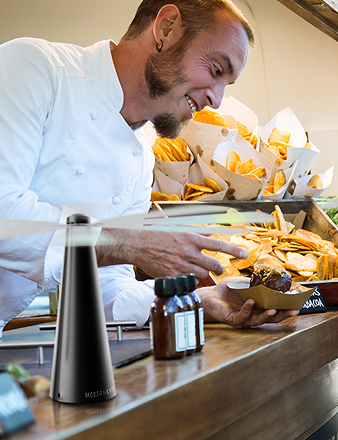The fastest way to keep flies from ruining your outdoor meal is to make the area unattractive to them. It’s a simple, two-step process: clean up what draws them in, then use a physical barrier—like the steady breeze from a fly fan—to protect your food and guests.
Why Your Patio Is a Fly Magnet
Nothing ruins a backyard barbecue faster than a swarm of persistent flies. To win this battle, you have to understand what they want. Flies are constantly searching for food, water, and a place to lay eggs, and your patio often provides all three.
Your outdoor dining setup is often irresistible to them. Flies are hardwired to search for food, water, and a place to breed, and an alfresco meal checks all those boxes.
What’s Drawing Flies to Your Table?
The things that attract flies are usually simple and easy to overlook. The key is to spot and deal with them before you bring out the food. Think of it as fly-proofing your space.
Here’s what’s on their radar:
- Enticing Smells: The scent of grilled food, a sweet drink, or fresh fruit is a dinner bell for flies. Even a few crumbs or a sticky spill is an open invitation.
- Standing Water: Flies need water to drink and breed. A small puddle, a saucer under a potted plant, or a pet’s water bowl can quickly become a fly hotspot.
- Trash Bins: An open or overflowing garbage can is a five-star resort for flies, offering a buffet and a nursery in one place.
When you get rid of these attractants, you’re doing more than just swatting flies. You're removing their entire reason for showing up. This is the foundation of any effective fly-control strategy.
To make this clearer, here’s a quick guide to creating a space that naturally keeps flies away.
Quick Guide to a Fly-Free Zone
| Strategy | Why It Works | Action Step |
|---|---|---|
| Eliminate Food Odors | Flies have a powerful sense of smell. No scent, no reason to visit. | Keep food covered until serving. Clean up spills and crumbs immediately. |
| Remove Standing Water | Deprives flies of essential water sources and breeding grounds. | Empty plant saucers, check for puddles, and keep pet bowls fresh. |
| Secure Garbage | Cuts off their main food supply and egg-laying destination. | Use trash cans with tight-fitting lids and place them away from your dining area. |
| Create Air Movement | Flies are weak fliers and dislike windy conditions. | Place a Modern Lyfe fly fan in the center of the table to create a protective air barrier. |
This table outlines the foundational steps. By turning these actions into habits, you set the stage for a peaceful, fly-free dining experience before the first dish is served.
Use Airflow to Your Advantage with Modern Fly Fans
One of the simplest and most effective ways to keep flies away while eating outside is to use their weakness against them: flies are terrible fliers. Their small bodies and flimsy wings can't handle a steady breeze, making it nearly impossible for them to land.
This is where a fly fan becomes your secret weapon. Not a large, noisy fan that blows napkins away, but a tabletop fly fan. Modern Lyfe fans generate a gentle vortex of air directly over your food, creating an invisible shield that flies can't penetrate.
The design is smart. First, the constant airflow disrupts their flight path, making it too difficult to navigate and land. Second, many of these fans have soft, holographic blades. As they spin, they refract light, which a fly’s compound eyes perceive as a confusing and threatening visual, signaling them to stay away.
Getting the Placement Just Right
To create a truly fly-free zone, fan placement is crucial. You need to think strategically to create overlapping zones of air that leave no gaps for pests.
Here’s what works best for different setups:
- A standard four-person table: One fan in the middle provides perfect coverage.
- A long rectangular table (for 6-8 people): Use two fans. Place one at each end to maintain a continuous airflow over the entire table.
- Large buffet-style spreads: Place a fan every four to six feet along the spread to keep every dish protected.
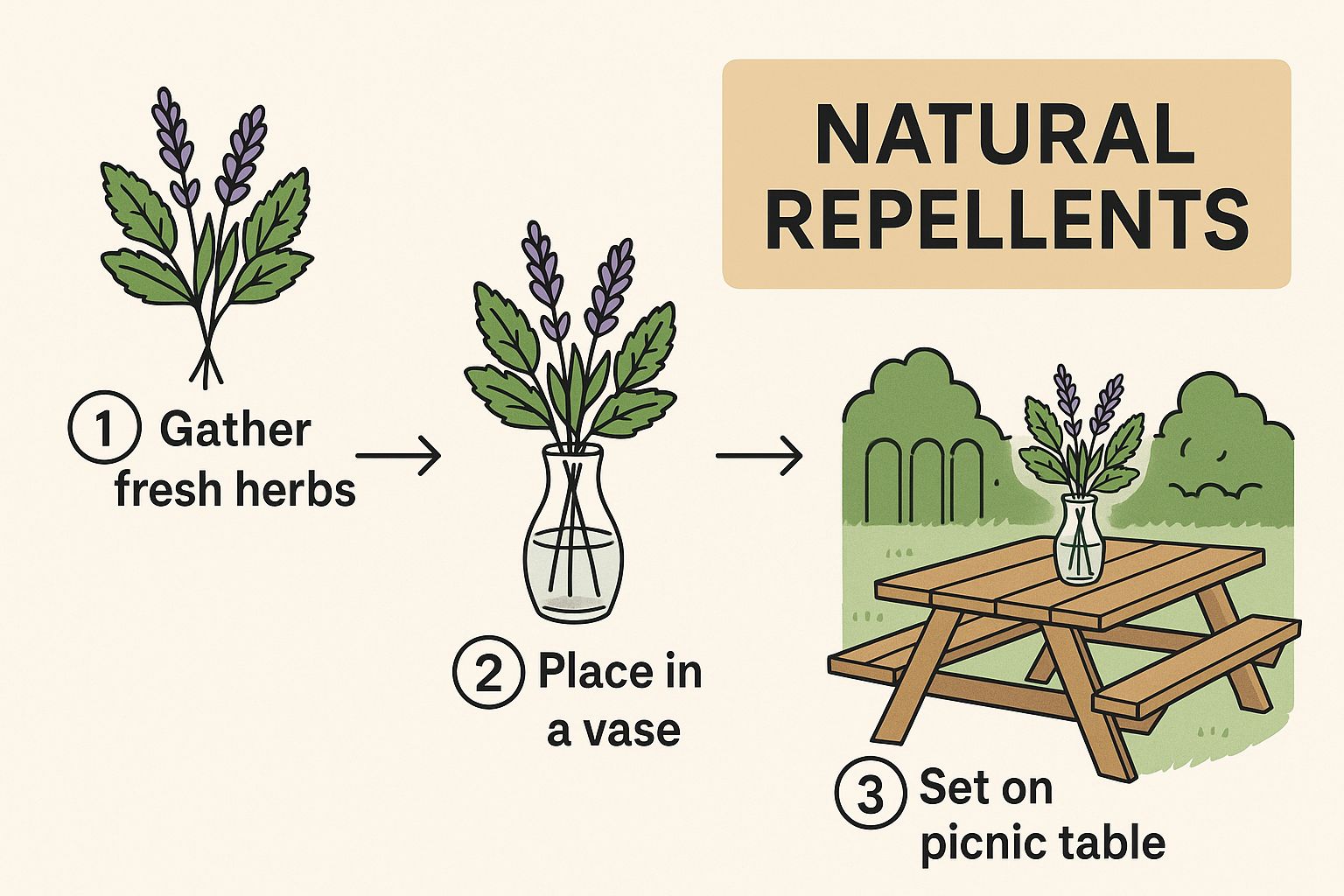
Combining the airflow from fans with natural scent deterrents builds a stronger, multi-layered defense that flies will find nearly impossible to breach.
The goal isn't to create a windstorm, but a gentle, continuous air current directly over your food. It should be subtle enough that you barely notice it, but strong enough to create a no-fly zone.
It’s a simple, silent, chemical-free solution. If you're curious about the science, you can learn more about how fly fans work and see why they are a go-to for outdoor dining.
Winning the Fly War Before It Starts: Smart Sanitation
A fly-free meal isn't just about what you do when the food is out; it’s about what you do before. The best defense is a good offense, which means making your outdoor space as unappealing to flies as possible from the start.
Flies are drawn in by smell and can detect food from surprising distances. A sticky spot on the deck, lingering grease on the grill, or crumbs under the table are like a flashing "free buffet" sign. Your job is to turn that sign off.
A Quick Pre-Meal Clean-Up
Before bringing out the plates, take five minutes to do a quick sanitation sweep. This isn't deep cleaning; it's a strategic mission to eliminate fly magnets.
A few small actions make a huge impact:
- Scrub the Grill: Scrape the grates and wipe off grease splatters. Leftover barbecue scent is a major fly attractant.
- Wipe Up Spills: Clean that drip of lemonade or dot of ketchup immediately. Check the ground under the table, too.
- Tidy the Area: Clear away fallen leaves or other yard debris near your dining spot, as flies hide and breed there.
Doing this consistently disrupts the scent trails that lead flies directly to your party.
You're creating a neutral zone. When you remove the smells that attract flies, your other tools—like fly fans and natural repellents—become far more effective.
The Two Most Overlooked Fly Havens
Even with a clean space, two things can sabotage your efforts: the trash can and uncovered food.
Your garbage bin is a five-star resort for flies. The solution is simple: use a can with a tight-fitting lid and move it as far away from your dining area as possible.
Once food is served, physical barriers are essential. Mesh food tents or cloches are brilliant because they block flies and trap the aromas that call them over. Our guide on how to keep flies away from food dives deeper into this.
By combining a clean environment with physical food covers, you create a powerful defense against pests. Studies on effective outdoor pest management have shown that these basic sanitation methods can reduce fly problems by as much as 70%.
Lean on Natural Repellents and Smart Landscaping
Beyond airflow and sanitation, you can use nature's own pest control. Layering your strategy with scents that flies hate is a great way to make your dining area an official "no-fly zone." This moves you past temporary fixes toward a more permanent, pleasant environment.
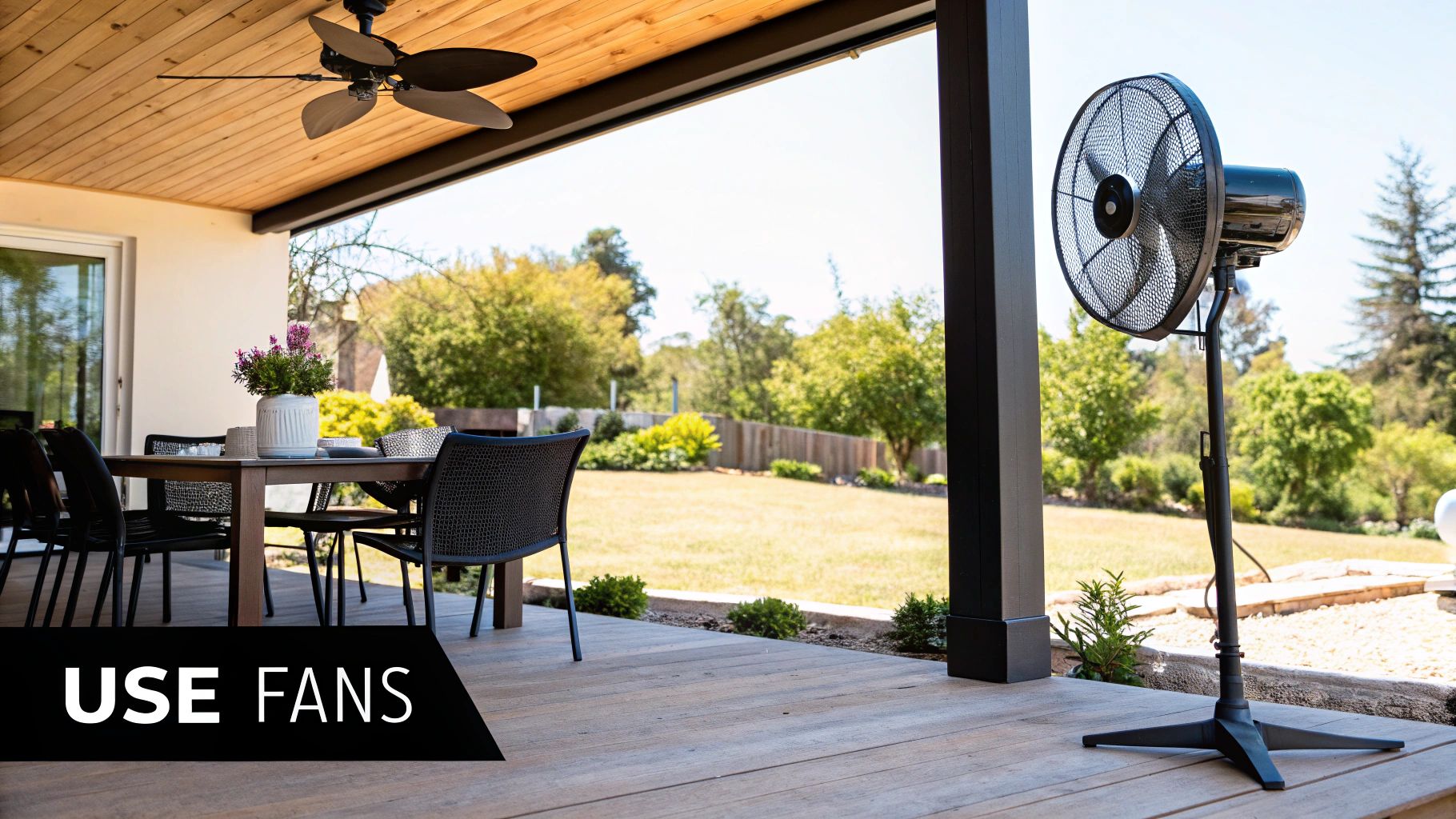
Many common herbs contain essential oils with aromas that are lovely to us but offensive to flies. Integrating these into your patio setup is both practical and beautiful.
Plant a Protective Scent Barrier
Create a "scent barrier" around your patio by planting certain herbs in pots or garden beds near your outdoor space. This makes the entire area less appealing for flies to approach.
Some of the best plants for the job include:
- Basil: Its strong, peppery scent is a major fly deterrent. A small pot on your dining table can work wonders.
- Lavender: We love its calming smell, but flies and moths can't stand it. It's perfect for planters near seating.
- Mint: This herb grows aggressively and releases a refreshing scent that flies despise. Grow it in a container to prevent it from taking over your yard.
- Rosemary: The classic, woody scent of rosemary is another powerful repellent for many insects, including flies.
Pro Tip: Place potted herbs strategically—on the dining table, next to chairs, and along the perimeter of your patio. This creates overlapping zones of repellent scents for maximum effect.
For a quick fix, use bug-repelling decor. Citronella candles or tiki torches are classics because they release scents that help mask the food smells attracting flies. You can find more tips on using repellent decor from Able Pest Management.
You can also create a simple DIY repellent. Slice a lemon or orange in half and stud it with whole cloves. It's surprisingly decorative and releases a scent that flies will actively avoid.
Stepping Up Your Game for Serious Fly Problems
Sometimes, simple tricks aren't enough. If you're dealing with a relentless swarm of flies or planning a big event, you need to think beyond basic repellents. This is about getting strategic with your defenses without resorting to harsh chemicals.
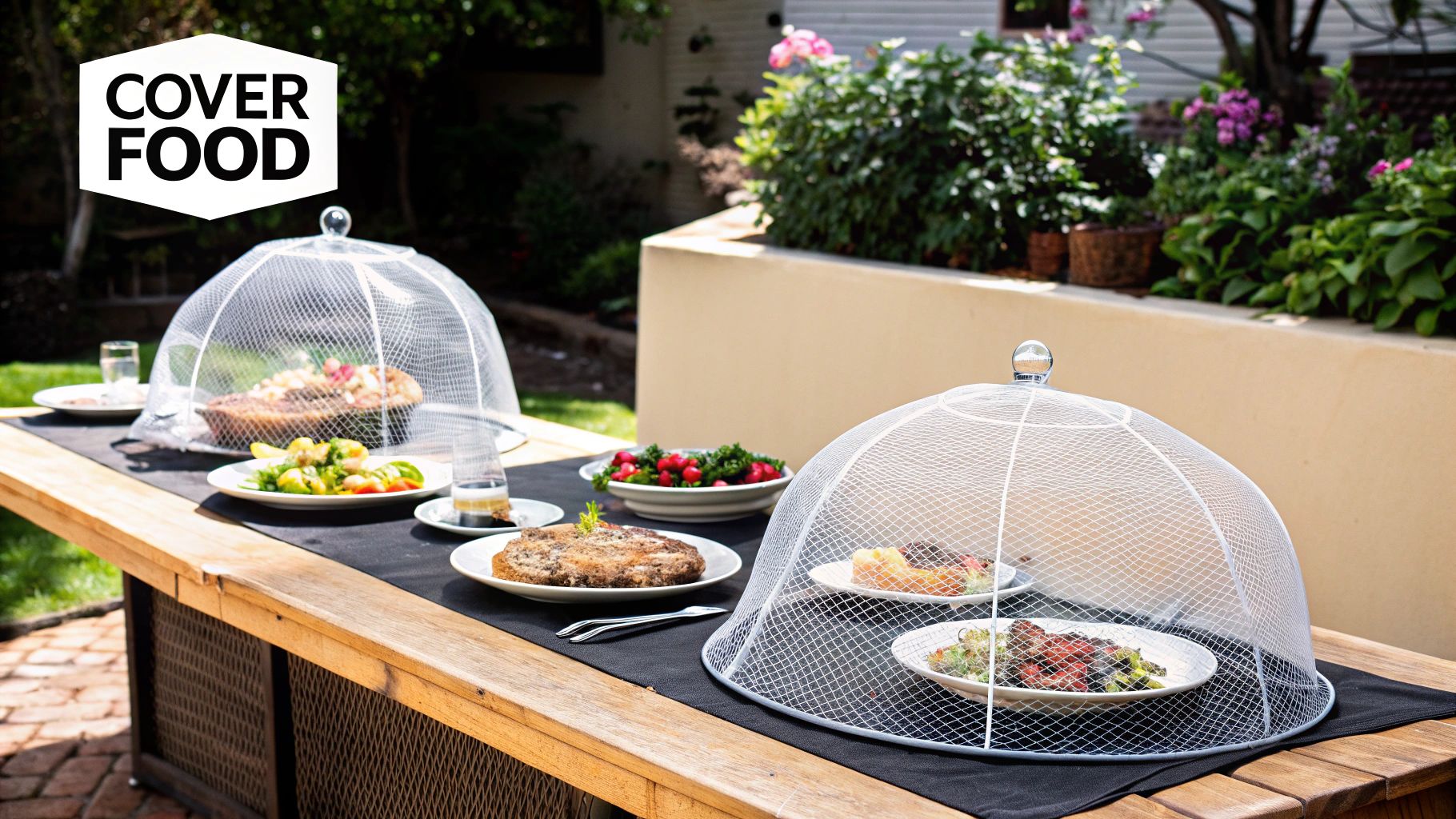
When the flies are winning, it's time for bigger guns. Think physical barriers and smarter technology to create a true fly-free zone. Electronic fly traps that use UV light, for example, can be incredibly effective at attracting and eliminating flies.
Think Like a Pest Control Pro: Placement is Everything
A common mistake is placing traps right next to the picnic table. This backfires. While the traps kill flies, they also attract them, bringing the swarm right to your dining area.
The secret is to place them strategically along the perimeter of your patio or yard. This tactic intercepts pests and draws them away from your food and guests before they get close.
For the most reliable, long-term solution, nothing beats a physical barrier. A screened-in porch or a gazebo with fine netting is the gold standard for creating a peaceful, pest-free dining sanctuary. Pest control experts call this "exclusion"—physically blocking pests from entering your space.
Studies confirm this is the right approach. Experts recommend a combination of screens, sealed entry points, and UV traps placed away from main activity areas. You can dive deeper into these effective fly control strategies on PMC.
By setting up perimeter traps and using physical barriers, you create a powerful defense. You aren’t just waving flies away—you’re actively capturing them and blocking their path entirely. This is the ultimate strategy for enjoying your meal in peace.
Common Questions About Keeping Flies Away
Even with a solid plan, specific questions often arise when you're trying to enjoy a meal outdoors. Let's clear up a few common myths and tackle some practical challenges.
Do Water Bags With Pennies Actually Work?
This is a classic home remedy, but there's very little solid proof it works. The theory is that water and shiny pennies create a prism-like effect that confuses a fly’s compound eyes.
While it's a neat idea, scientific studies haven't proven it to be a reliable deterrent. You’ll get better results by sticking to proven tactics—using a fly fan, keeping your space clean, and using natural scents they hate.
Are Bug Zappers a Good Choice for the Patio?
Bug zappers are effective at killing insects, but they shouldn't be placed near where people are eating. The constant zapping sound is annoying, and worse, it can send tiny insect particles into the air—the last thing you want around your food.
A smarter strategy is to place UV traps along the edge of your yard. This lures flies away from your gathering instead of into it. For the table itself, a quiet, simple fly fan is a much safer and more pleasant solution.
How Do I Handle a Fly Invasion at a Big Party?
When hosting a large BBQ or event, you need to scale up your fly control. A single fan won't be enough. A layered defense is the only way to go.
- Bring in Reinforcements: Use multiple fly fans. Place one for every 4-6 feet of a buffet or long dining table to create an overlapping no-fly zone.
- Centralize the Trash: Set up a dedicated sanitation station with sealed trash and recycling bins, located well away from where guests are eating.
- Keep Food Under Wraps: Use large mesh food tents to cover the entire buffet line. It’s a simple but highly effective barrier. For more ideas, see our guide on keeping flies away from food outside.
Ready to enjoy your outdoor meals in peace? The Modern Lyfe fly fan is a simple, stylish, and effective solution for any patio or picnic. Shop now and reclaim your backyard!

